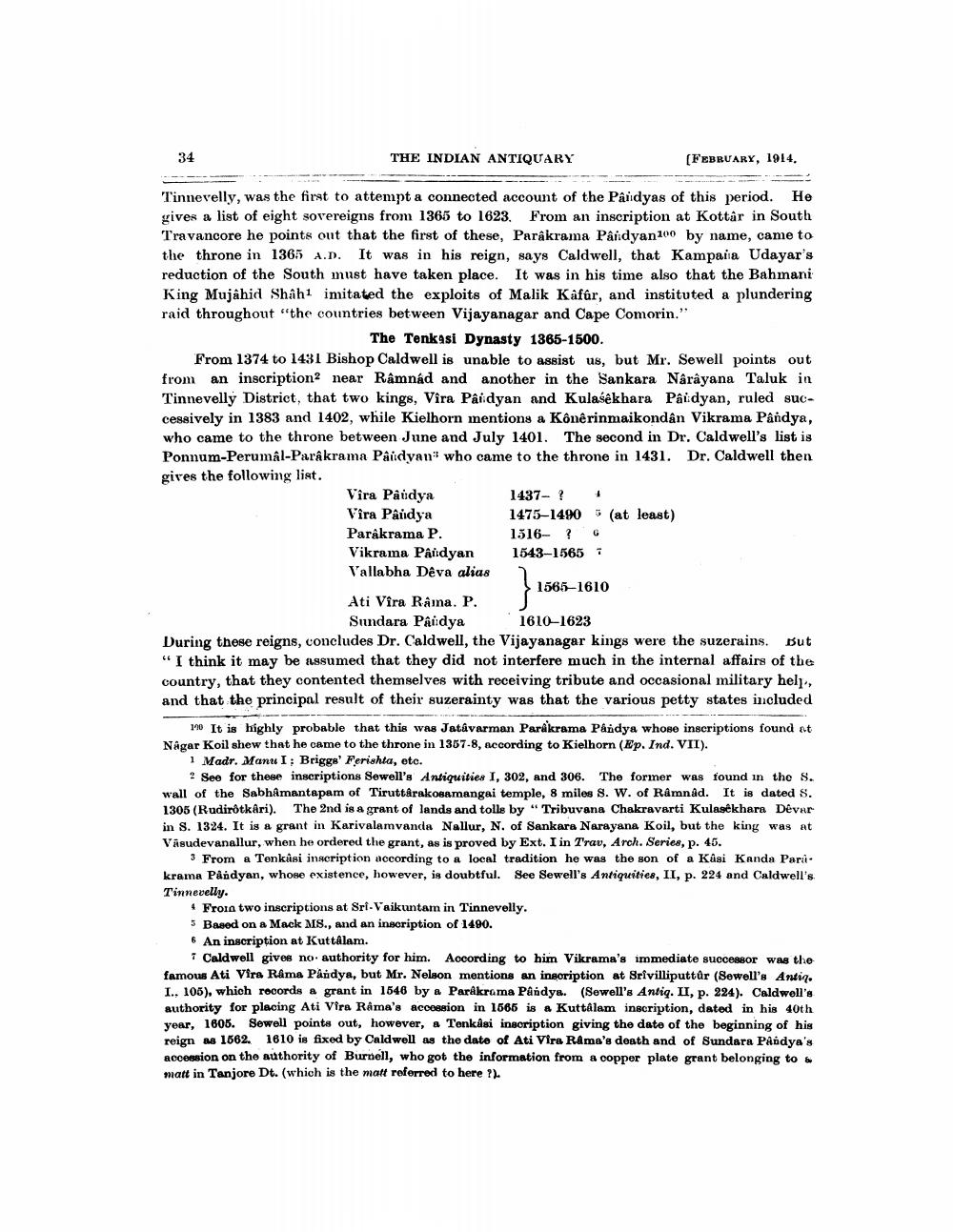________________
34
THE INDIAN ANTIQUARY
(FEBRUARY, 1914,
Tinnevelly, was the first to attempt a connected account of the Paidyas of this period. He gives a list of eight sovereigns from 1365 to 1623. From an inscription at Kottar in South Travancore he points out that the first of these, Parakrama Pârdyan 100 by name, came to the throne in 1365 A.D. It was in his reign, says Caldwell, that Kamparia Udayar's reduction of the South must have taken place. It was in his time also that the Bahmani King Mujahid Shahi imitated the exploits of Malik Kafür, and instituted a plundering raid throughout "the countries between Vijayanagar and Cape Comorin."
The Tenkasi Dynasty 1365-1500. From 1374 to 1431 Bishop Caldwell is unable to assist us, but Mr. Sewell points out from an inscription2 near Râmnád and another in the Sankara Narayana Taluk in Tinnevelly District, that two kings, Vira Paidyan and Kulasekhara Paidyan, ruled successively in 1383 and 1402, while Kielhorn mentions a Kônêrinmaikondân Vikrama Pandya, who came to the throne between June and July 1401. The second in Dr. Caldwell's list is Ponnum-Perumal-Parakrama Paidyan) who came to the throne in 1431. Dr. Caldwell then gives the following list.
Vîra Paudya
1437- ? + Vîra Pâudya
1475-1490 5 (at least) Parâkrama P.
1516- ? Vikrama Paidyan 1543-1565 1 Vallabha Dêva alias
1565-1610 Ati Vira Rama. P.
Sundara Paidya 1610-1623 During these reigns, concludes Dr. Caldwell, the Vijayanagar kings were the suzerains. But "I think it may be assumed that they did not interfere much in the internal affairs of the country, that they contented themselves with receiving tribute and occasional military hely, and that the principal result of their suzerainty was that the various petty states included
190 It is highly probable that this was Jatavarman Paråkrama Pandya whose inscriptions found at Nagar Koil shew that he came to the throne in 1357-8, according to Kielhorn (Ep. Ind. VII).
1 Madr. Manu I: Briggs' Ferishta, etc.
? See for these inscriptions Sewell's Antiquities I, 302, and 306. The former was found in the 8. wall of the Sabhamantapam of Tiruttarakobamangai temple, 8 miles S. W. of Râmnad. It is dated S. 1305 (Rudirôtkåri). The 2nd is a grant of lands and tolls by "Tribuvana Chakravarti Kulasekhara Devar in S. 1324. It is a grant in Karivalamvanda Nallur, N. of Sankara Narayana Koil, but the king was at Vasudevanallur, when he ordered the grant, as is proved by Ext. I in Trav, Arch. Series, p. 45.
3 From a Tenkasi inscription according to a local tradition he was the son of a Kasi Kanda Parii. krama Pandyan, whose existence, however, is doubtful. See Sewell's Antiquities, II, p. 224 and Caldwell's Tinnevelly.
4 Froin two inscriptions at Sri Vaikuntam in Tinnevelly. 5 Based on a Mack MS., and an inscription of 1490. 6 An inscription at Kuttalam.
7 Caldwell gives no authority for him. According to him Vikrama's immediate successor was the famous Ati Vira Rama Pandya, but Mr. Nelson mentions an insoription at Srivilliputtar (Sewell's Antin. I.. 106), which rocords « grant in 1646 by a Paråkrama Pandya. (Sowell's Antiq. II, p. 224). Caldwell's authority for placing Ati Vira Rama's accession in 1565 is a Kuttalam inscription, dated in his 40th year, 1605. Sewell points out, however, a Tenkasi inscription giving the date of the beginning of his reign as 1562. 1610 is fixed by Caldwell as the date of Ati Vira Rama's death and of Sundara Pandya's accession on the authority of Burnell, who got the information from a copper plate grant belonging to mattin Tanjore Dt. (which is the matt referred to here ?).




